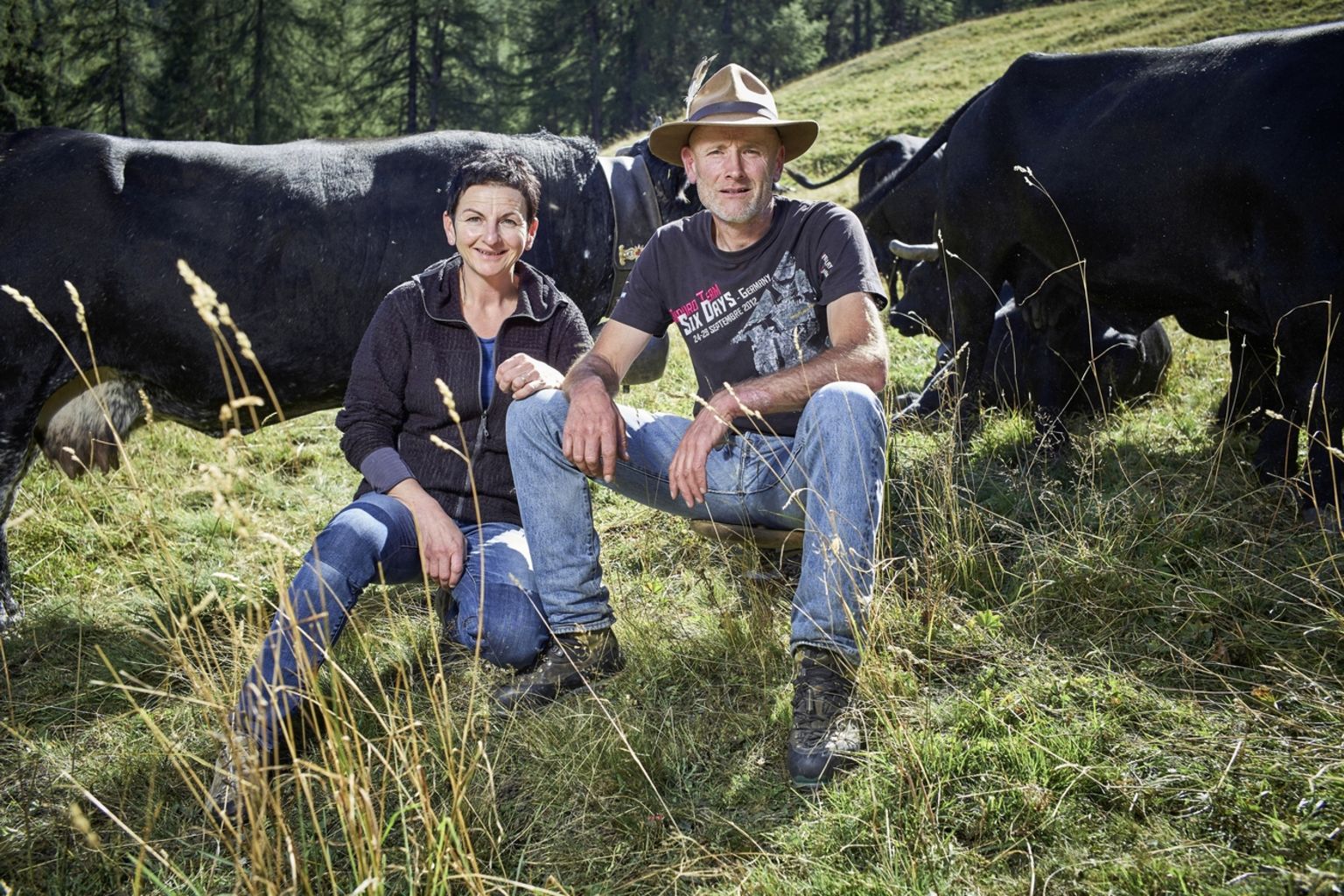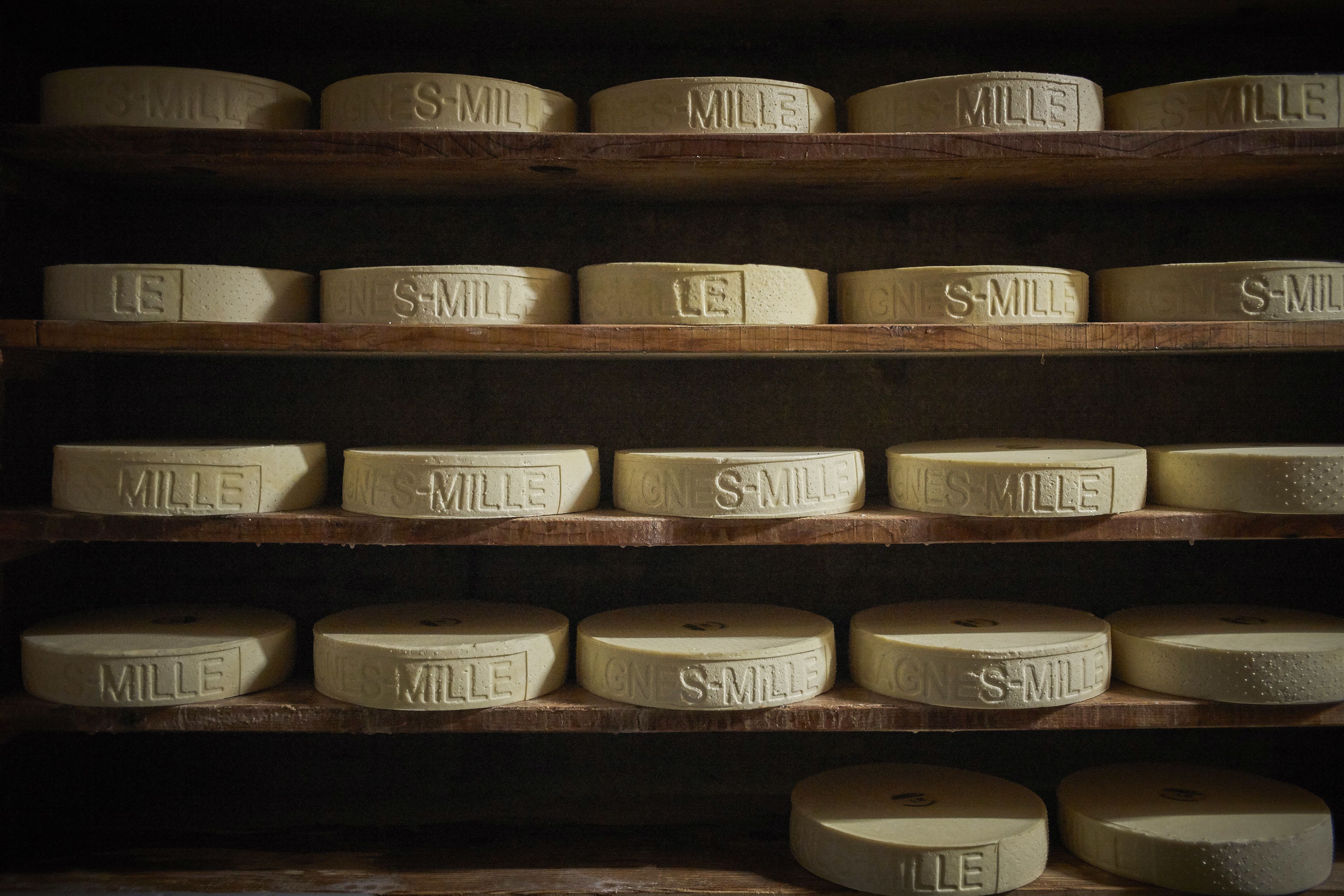The fruit of a summer

High in the Valais Alps, long hours of manual work go into the production of Raclette du Valais AOP cheese. The cows spend the summer grazing up on the alpine pastures, where experts turn the untreated milk into the finest cheese. A visit to the Mille dairy above the Val de Bagnes.
Twice a day, milk churns line up in front of the cheese dairy at the Mille alpine pastures. They contain milk from the 250-odd cows who spend the summer here, high up in the Val de Bagnes. The white liquid gold is still warm when it is poured into the big copper cauldron. The cheese-maker, Christophe Prodanu, then lights the gas burner to heat the milk up to a temperature of 32 degrees before he adds the rennet. “It takes good milk, a cheese-maker who knows their craft, and the right temperature,” says Christophe. That makes it sound easier than it is. Here, the team makes Raclette du Valais AOP cheese, and Mille is just one of about 50 cheese dairies up on the alpine pastures and about 25 others down in the valleys that make the cheese in the canton according to traditional methods and strict regulations.

It is only in the last couple of years that cheese has been made up here. For the previous 20 years, the milk had to be transported down to the valley. The tenants at Mille for the past seven years have been Catherine and Pierre-Alain Michellod. They own a business in Versegères down in the valley but, Catherine says, “my husband wants to spend the summer on the alpine pastures. He loves the tranquillity up here and the work with the cows. You couldn’t take his alpine summer from him.” She admits, however, that it is tough work, very tough – for her, too. She has to ensure that Pierre-Alain, his eight colleagues, the cheese-maker Christophe and his wife Carmen always have enough to eat, and also that the fruit of their labour travels safely down to the valley for maturing and for sale in the shops. Which means specifically: driving backwards and forwards by car, taking orders, shopping, running the business down in the valley, keeping an overview of everything, lots of telephoning and loads of paperwork. Last summer, they produced 1,800 wheels of cheese, which required about 85 tons of milk. Most was made into Raclette cheese, some into tomme. The whey that is left over is used to make soft white sérac cheese, which is sold fresh down in the valley.
Running an alpine pasture is extremely heavy work. Days are long. For the tenant, Pierre- Alain Michellod, they begin at about 4 am. That’s when he gets up, takes his milking stool and milk can and goes to his 40 Herens cows in their fenced enclosure on the pastures. He milks them by hand: “that way they give more milk,” he says. Alongside their own Herens cows, the Michellods also graze Simmental cattle, who are milked by his colleagues using a mobile milking machine. After milking there’s breakfast, and then the cows are released again to graze and, if necessary, led higher up the pastures.

Between the cows’ ascent from the valley at the beginning of June and their descent in September, they graze on four different alpine pastures. In August, they reach their highest point, before heading back down in stages. “Depending on the grass and plants that they eat, the milk changes,” Pierre- Alain says. Which leads to subtle differences in flavour in the cheese: as Catherine Michellod says, “that gives the cheese its identity.” The grass at the highest point is less lush and nourishing than lower down; the cows also produce less milk over the course of the summer.
Pierre-Alain enjoys being with his cows, watches to make sure they have enough to eat and hears, thanks to the cowbells, if one goes astray. He must keep an eye on everything and observe carefully, because the cows are scattered over large areas. At lunchtime, the cowherds meet in the mountain cabin and can relax for a short while. Soon, it is time for the second milking of the day. Depending on where the cattle are grazing, the milk churns and the mobile milking machine may have to be transported over long distances. The weather is not always good. Conditions can change quickly in the mountains: the wind can be strong and the rain heavy. “Me, I’m not bothered by it,” says Pierre-Alain. “Even when we sometimes have fog, I find it beautiful.”

Towards five in the afternoon, Christophe Prodanu has to light the gas burner again; he starts to process the day’s second batch of milk with a masterly touch. It was the Michellods who discovered the cheese-maker from the French-speaking Jura region and engaged him: “an exceptional craftsman,” says Catherine. And well-travelled, too: some years he spends the winter in Chewton in Australia, where he makes cheese from organic goat’s milk at a farm dubbed “Holy Goat”. He is also invited to give talks there on his life up on the alpine pastures. “I need nature around me,” he says, “I could never work in an office. I feel really privileged working up here.” He appreciates not just the high-quality milk, but also the dairy and especially the cellar where the cheeses are stored. “It is always a little damp in there, so it has perfect conditions for the cheeses to mature.”

Each wheel of Raclette du Valais AOP bears its area of origin stamped on the rind – “Bagnes”, for example, “Gomser” or “Wallis 65” – so customers can see where it was made. Cheese from the Mille alpine pastures is stamped “Bagnes-Mille”. To be sold as Raclette du Valais AOP, the cheese must mature for at least three months. Last year, all qualifying cheese dairies brought a total of 1,916 tons onto the market. A dedicated association checks the dairies regularly. Up on the Mille alpine pastures, work is never over before 10 pm – even though the days begin at four in the morning. “Yes, it’s tough,” says Pierre-Alain. “But when you love it…”
Life should become a little easier, Catherine says, now their son has taken over the business down in the valley. Their three daughters will also help out when extra hands are needed. From this summer, this will be at a different alpine pasture: Le Lein, where the Michellods and their cheese-maker, Christophe Prodanu, will spend the season along with their herds of cattle. And there, too, they will once again produce Raclette du Valais AOP – this time with the stamp “Le Lein”.

Text: Monique Ryser Photographs: Sedrik Nemeth
Published: July 2019
On the wine trail.
Next story



